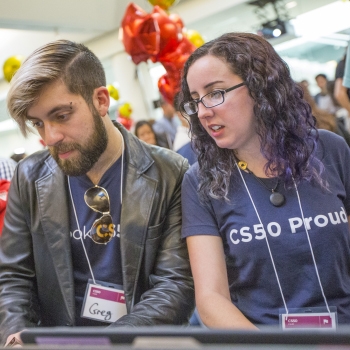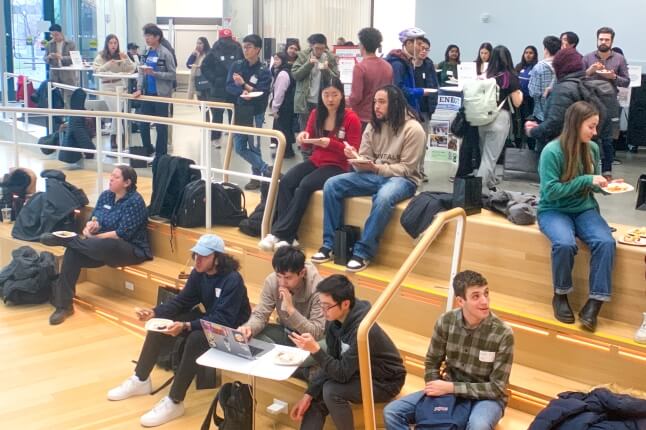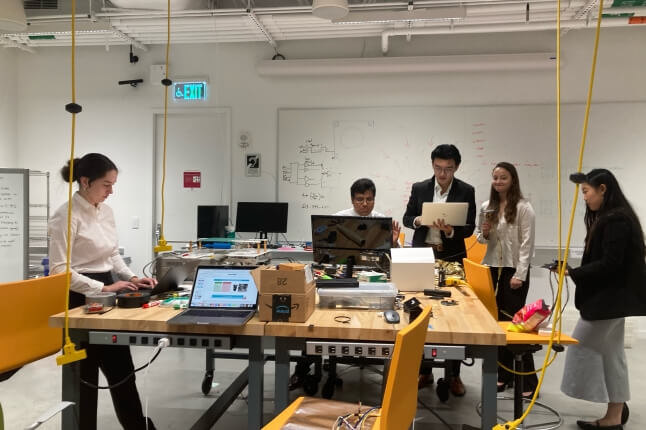News
Students explore the world of creative apps on display at the CS50 Fair. Final project fairs are an opportunity for students to showcase their best work from some of the most popular, hands-on courses at SEAS. (Photo by Eliza Grinnell/SEAS Communications.)
Many of the devices on display at end-of-term student project fairs, from brightly glowing LEDs to music-making microcontrollers, seemed less like course assignments and more like high-tech holiday party supplies.
Among the highlights were creative gadgets and clever apps produced by students in three hands-on engineering and computer science courses at the Harvard John A. Paulson School of Engineering and Applied Sciences: Introduction to Electrical Engineering (ES50), The Joy of Electronics (ES52), and Introduction to Computer Science (CS50).
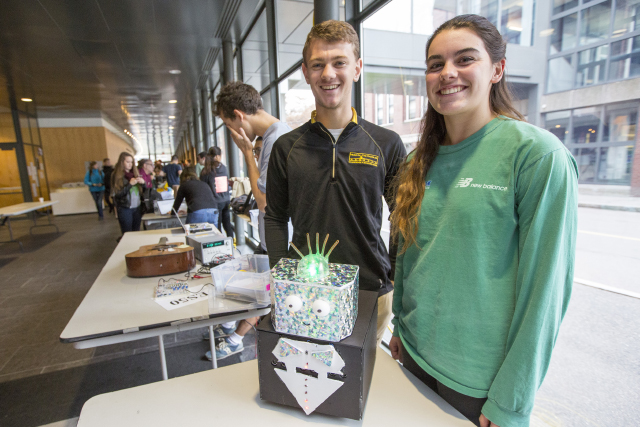
Nick Kochanek, A.B. '19, a computer science concentrator, and Grace Eysenbach, S.B. '20, an electrical engineering concentrator, set out to develop a robotic pet that is as lovable as a real puppy. (Photo by Eliza Grinnell/SEAS Communications.)
Created by Nick Kochanek, A.B. ’19, a computer science concentrator; and Grace Eysenbach, S.B. ’20, an electrical engineering concentrator, for ES50
Noah, a rolling robotic “pet,” incorporates distance sensors that send out high-frequency pings to measure the space between the robot and nearby objects. The robot drives toward objects that are farther away and backs away from objects that get too close, Kochanek explained, in a similar manner to how a dog might follow its owner around a crowded room. To make the robopet even more lovable, he and Eysenbach programmed a light bulb on Noah’s head to glow green when someone pets it.
“While we had a lot of fun bringing together a number of microcontrollers into one package, trying to program all the sensors to work together was challenging,” Kochanek said. “When you have so many wires, there is always something that can go wrong.”
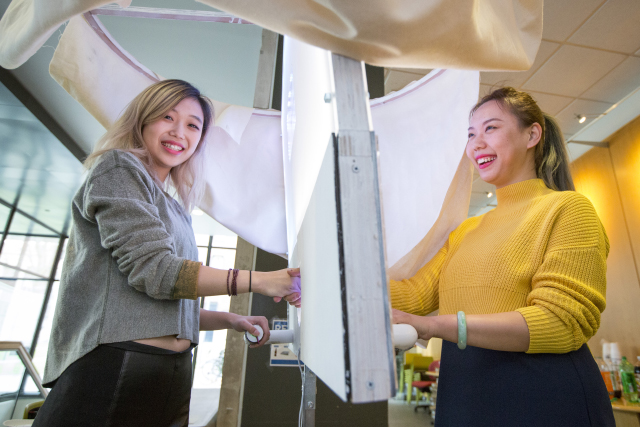
Graduate School of Design master's students Xinyun Huang ’17 (left) and Hanwei Li ’17 demonstrate how their team used technology to create an interactive, public art project. (Photo by Eliza Grinnell/SEAS Communications.)
Wanna Touch?
Created by Hanwei Li ’17, Xinyun Huang ’17, and Taro Kagami ’17, master’s students at the Graduate School of Design, for ES50
The public art project created by Li, Huang, and Kagami is designed to get people talking, literally. Two individuals stand on either side of an opaque screen, each grasping a capacitive sensor that sets off a “conversation starter” in the form of colorful lights that glow in different patterns. At the same time, participants also place their thumbs onto a pulse sensor. Once each person’s pulse increases to a certain level, the translucent screen becomes clear and the other person’s face is revealed.
“Technology can keep people from getting out and meeting one another, but in this case, we use it to help people connect,” said Li. “Maybe the two people on either side come from different cultures and would never have met, or maybe they have something in common to share that they wouldn’t have known about otherwise.”
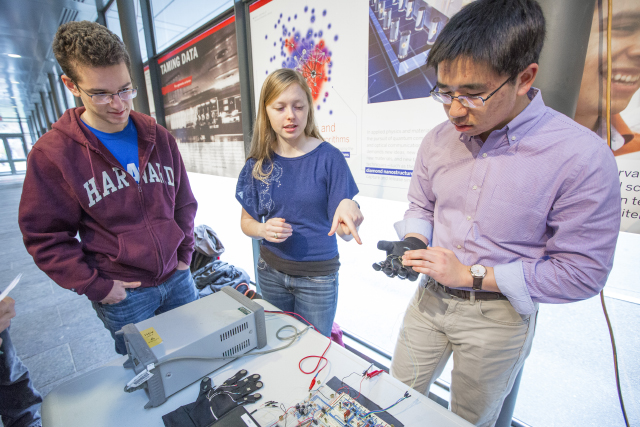
(From left) William Bryk, A.B. '19, a physics and computer science concentrator, Kira Headrick, S.B. '17, a mechanical engineering concentrator, and Franklin Li, S.B. '17, a mechanical engineering concentrator, explain how they used pressure sensors to turn a pair of gloves into musical instruments. (Photo by Eliza Grinnell/SEAS Communications.)
Gloviáno
Created by William Bryk, A.B. ’19, a physics and computer science concentrator; Kira Headrick, S.B ’17, a mechanical engineering concentrator; and Franklin Li, S.B. ’17, a mechanical engineering concentrator, for ES52
Bryk, Headrick, and Li retrofitted a pair of gloves with pressure sensors, which are connected to a microcontroller that can play musical notes at three different frequencies. By pressing harder onto a surface with their fingers, users can increase the volume of the three tones, Headrick explained. In addition, they can change the octaves of each glove and set a metronome to keep time. The gloves also enable users to play along with a previously recorded song, which could be a handy way to teach someone to play the piano, Bryk said.
“Designing and building something on our own was an entirely different ballgame from a typical class project,” Headrick said. “For instance, integrating all the circuits was a monumental task. Despite all that, it came together in the end, and it has been very gratifying to know we were able to work through all the bugs.”
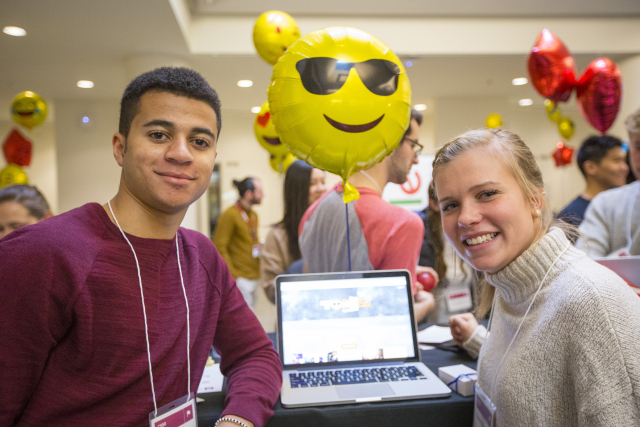
Derek DaSilva, A.B. '19, a statistics and computer science concentrator, and Emma Stone, A.B. '19, a neurobiology concentrator, used their team's web app to show attendees at the CS50 Fair how music and emotions are interrelated. (Photo by Eliza Grinnell/SEAS Communications.)
Created by Derek DaSilva, A.B. ’19, a statistics and computer science concentrator; Emma Stone, A.B, ’19, a neurobiology concentrator; and Michael Bervell, A.B. ’19, a computer science and philosophy concentrator, for CS50
The web app devised by DaSilva, Stone, and Bervell enables users to find music that corresponds to their emotional state. After a ToonZ! user selects one of 50 emojis to signify his or her current mood, the site links to a webpage of Spotify playlists that correspond to that temperament (heavy metal playlists for an angry face emoji, for example). Users can listen to samples and then add selected playlists to their own Spotify accounts. Stone said the project highlights how emojis transcend cultures and languages, possibly helping users around the world find common ground through music and emotions.
“This project taught me a lot of problem solving skills and how to work well together as a team,” DaSilva said. “Enabling the Spotify integration was the hardest part, since we needed to learn the code their developers used so we could break it apart and then put the pieces back together for our project.”
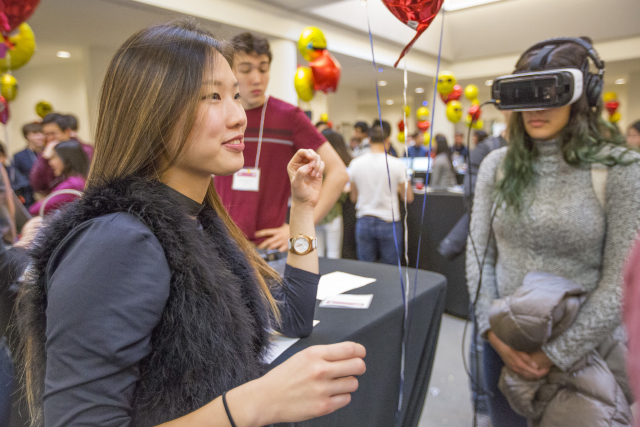
Christine Hong, A.B. '19, a computer science concentrator (left), explains her team's project while a CS50 Fair attendee enjoys the Zen-like virtual reality environment they created. (Photo by Eliza Grinnell/SEAS Communications.)
VReflections
Created by Christine Hong, A.B. ’19, a computer science concentrator and Tim Gallati, '18, a master’s student at the Harvard Divinity School, for CS50
No time to search for Zen in your busy life? Hong and Gallati have an app for that. They created a virtual reality environment modeled off The Society of Saint John the Evangelist’s monastery in Cambridge. An individual stands in the center of an open room, which features a celestial environment outside tall windows. Soft monastic chanting echoes in the background as an audio-responsive halo of glowing boxes overhead moves up and down as the frequency or pitch changes. The project taught Hong that there are many opportunities to use virtual reality to create a unique user experience.
“Technology is rapidly evolving while life is getting faster and faster paced,” Hong said. “We wanted to use technology to create an environment where people could take a deep breath and meditate. It was so much fun to be able to develop a kind of alternate universe.”
Topics: Academics
Cutting-edge science delivered direct to your inbox.
Join the Harvard SEAS mailing list.
Press Contact
Adam Zewe | 617-496-5878 | azewe@seas.harvard.edu
